18 Sept 2017
Ectoparasite infestation in winter-housed dairy cattle
Andrew Forbes discusses strategies for eliminating mange and lice over the housing period, including some case studies.

Figure 1. A typical presentation of chorioptic mange in a dairy cow.
Cattle are commonly infested with lice or mange mites over winter, when conditions favour expansion of their populations, with clinical disease typically appearing in late winter and early spring. The impact of lice and mange ranges from deaths due to anaemia in sucking lice infestations in calves to reductions in growth rates and milk yield to no measurable effect. Hence, the need for treatment needs to be assessed on a case-by-case basis.
Licensed ectoparasiticides for cattle are limited to two classes – the macrocyclic lactones and pyrethroids – which creates a potentially high selection pressure for resistance in the target parasites. Psoroptic mange is uncommon, but can pose therapeutic challenges. Housing treatments, preferably with topical formulations if biting lice or chorioptic mange are the focus, can provide strategic control of the two most common species. As lice and mange mites are species-specific – obligate parasites with limited survival off the host – they are candidates for elimination, at least at the farm level, and this can be contemplated, subject to satisfactory risk assessment and cost-benefit analysis.
Common ectoparasite infestations in dairy cattle at pasture are described in a companion article, in which the focus is on ticks and, predominantly, flies.
In contrast, in this article looking at ectoparasites commonly encountered in cattle over the winter housing period, flies are not featured.
Had this article been written 30 years ago, warble flies (Hypoderma species) would have figured strongly, as their larvae undergo peregrinations through cattle over winter before emerging from the dorsum in spring.
Warble flies were both common and notifiable (The Warble Fly [England and Wales] Order 1982); however, no evidence exists for endemic infestation in cattle in the UK with this genus since the 1990s (Sinclair and Tarry, 1993) – assumed, in part, to be the result of widespread use of ivermectin at housing.
Over winter, cattle become more susceptible to lice and mange mites as a result of thick coats providing a more favourable microclimate for some species, close contact between animals and low levels of UV light. In cattle, little appears to exist in the way of acquired, functional immunity to these obligate ectoparasites, hence infestations can be seen in animals of all ages.
The impact of these parasites on their hosts is diverse and low-grade infestations may have no perceptible impact on cattle, although, at the other extreme, severe clinical signs and mortality have been described.
The intention of this article is to cover several aspects of interest and practical importance for cattle clinicians, including some case studies. Readers are referred to review articles, such as Foster et al (2015), for more comprehensive and systematic coverage of mange and lice infestations.
Mange
Mange is a parasitic dermatitis resulting from infestation with species of mites – Chorioptes bovis, Sarcoptes scabiei and Psoroptes ovis. Additionally, Demodex bovis can cause mange, but is rarely observed in Europe and will not be discussed further.
Two species – C bovis and P ovis – live superficially on the skin surface, while S scabiei is found in burrows within the skin.
Although the taxonomic relationships between and within the different mite genera is still subject to some debate and active research, it appears the species/isolates that occur on cattle are essentially species-specific and, therefore, spread between the various domestic livestock species rarely occurs to any significant extent.
Chorioptic mange
Chorioptic mange appears to be the most common type of mange in cattle in the UK, although it is probably under-reported. Classically, it appears in housed, adult (dairy) cattle over winter and manifests as discrete areas of hair loss and hyperkeratinisation on either side of the tail head (Figure 1), hence its common name “tail mange”.
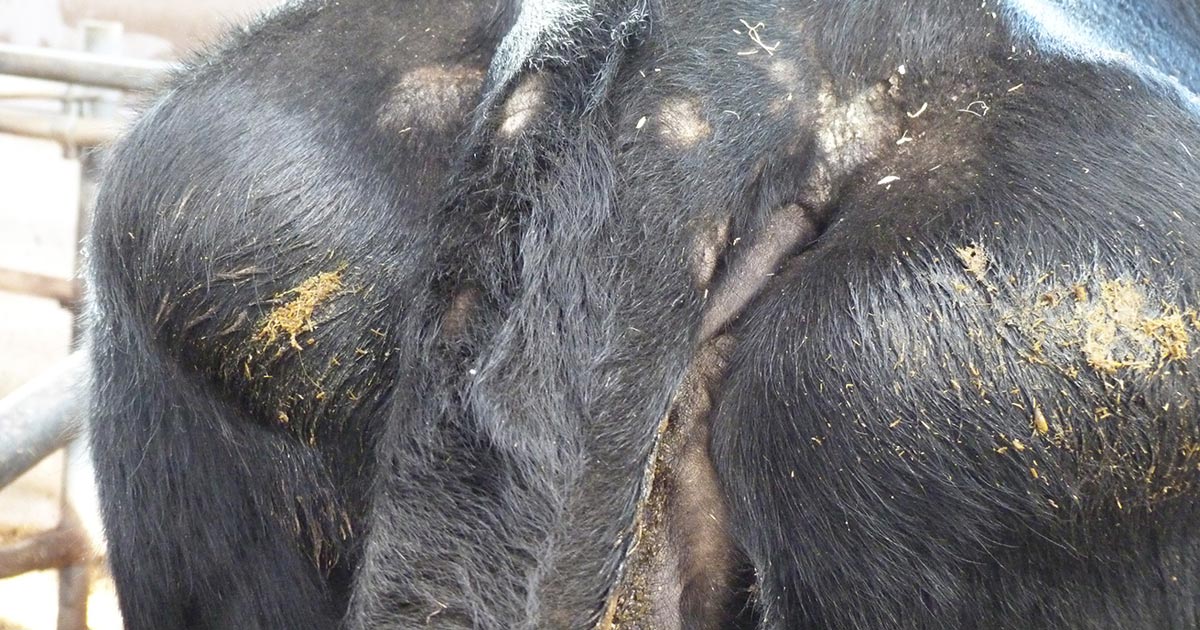
Older texts describe the hind pasterns of cattle (Figure 2) as being the most common predilection site for the mites (heel mange; Sweatman, 1956), but, possibly because of covering of mud/manure or the relative inaccessibility of the site, lesions are less frequently reported at these sites.
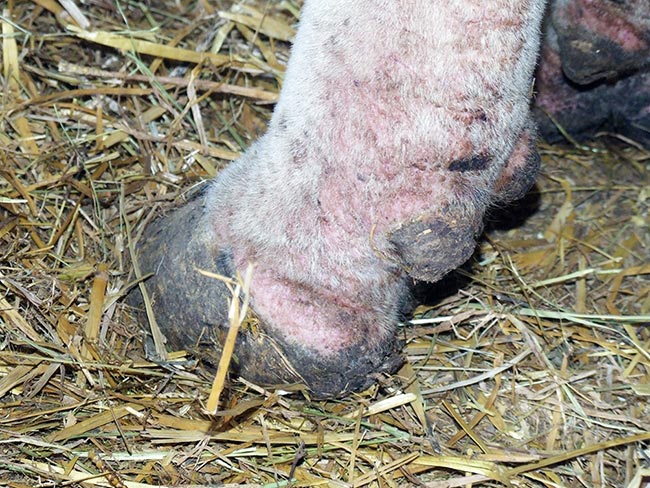
Infected cattle may be restless and rub against buildings and fittings in response to the associated pruritus; milking cows may kick off the clusters.
Production losses have been reported in lactating dairy cows, typically measured through response to acaricide treatments under controlled conditions (Rehbein et al, 2005; Villarroel and Halliburton, 2013). An atypically severe outbreak of chorioptic mange was observed in a dairy herd in south-west France, where the majority of cows had extensive mange lesions (Figure 3), from which only C bovis was recovered from samples collected (Forbes et al, 2007).
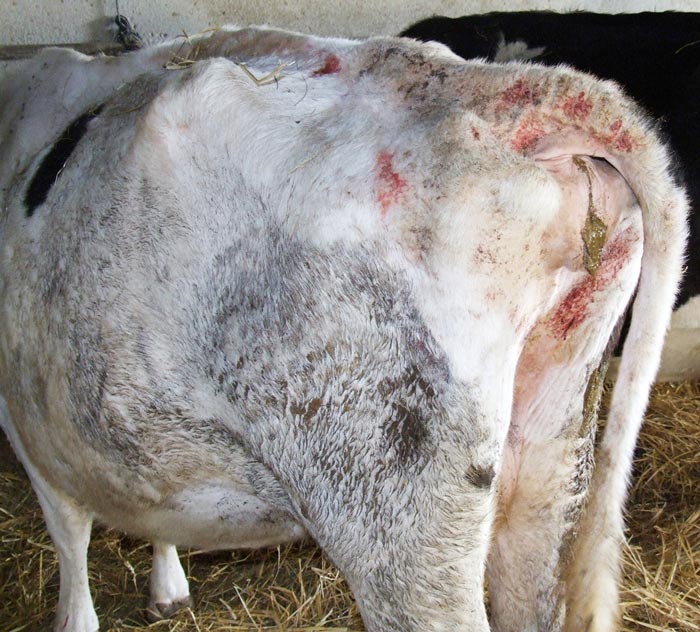
C bovis lives superficially on its host and does not appear to require to eat vital tissues to survive. Indeed, colonies of mites have been kept alive for eight months and completed several life cycles in the laboratory when provided with a supply of hair and skin detritus (Sweatman, 1956).
Even in the absence of such a substrate, mites can live up to 10 weeks off the host, with survival being favoured by low temperatures (Liebisch et al, 1985), so the propensity for indirect spread and reinfection is high.
Additionally, tethering of animals in stanchions appears to be a significant risk factor for infection and the severity of the consequent lesions. This is attributed to the restrictions placed on individuals in their ability to groom themselves and others, and also to relieve the pruritus.
Sarcoptic mange
In contrast to chorioptic mange, sarcoptic mange appears to be diagnosed more commonly in young animals and its predilection sites are more commonly associated with the head and anterior body. The mite life cycle takes place in the burrows in the skin, with consequent local tissue damage.
The appearance of the lesions is commonly that of thickening of the skin and crusting, but with little serum exudation. Nevertheless,self-inflicted trauma can lead to excoriation of the skin, and locally acute inflammation and haemorrhage. In a comparison between groups of young cattle infected with S scabiei – one of which was treated with ivermectin eight weeks after infection – the treatment resulted in a parasitological and clinical cure, when evaluated 28 days after treatment (Rehbein et al, 2003).
From the day of treatment to the end of the observations 56 days later, the ivermectin-treated group gained 53% more weight than the untreated, infested group. The weights of adrenal glands and drainage lymph nodes were significantly greater in the group that had mange, compared with animals in the treated group (Figure 4).
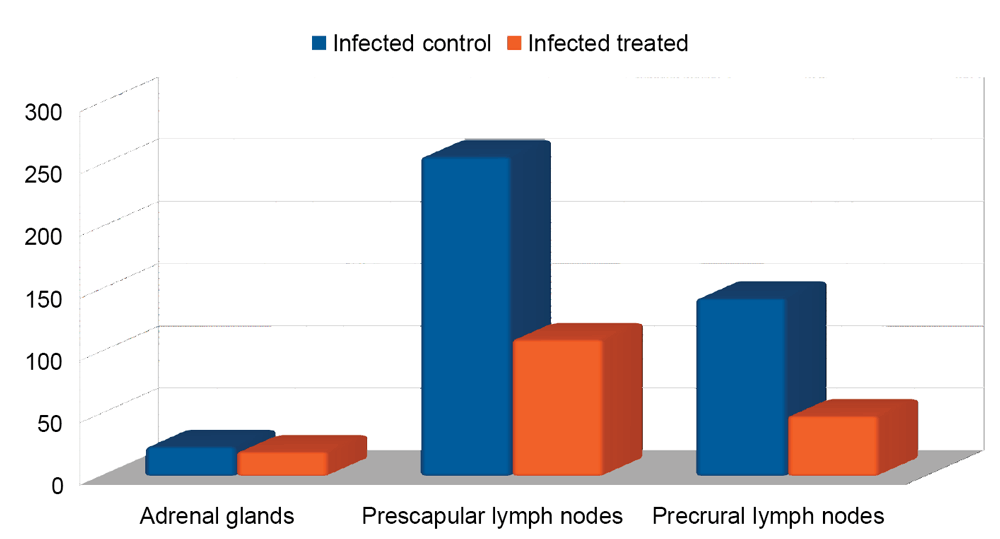
These results underline the importance of stress and the immune response in the pathogenesis of the disease, and the need to consider animal welfare in determining treatment/control options.
An atypical case of sarcoptic mange in a dairy herd (Watson and Forbes, 2000) was characterised by the absence of lesions around the head, but extensive lesions on either side of the tail down to the escutcheon and hocks (Figure 5). Only S scabiei was isolated fromskin scrapings.
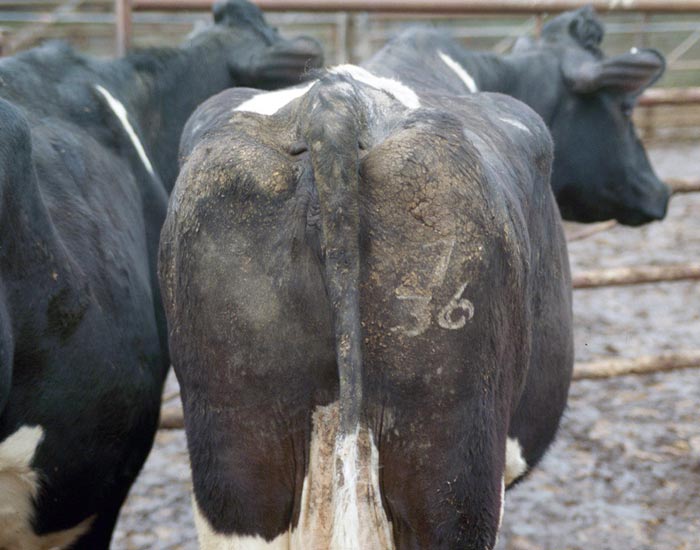
Response to eprinomectin treatment of the whole herd was rapid and associated with an increase in the volume of bulk tank milk. The herdsman observed the first indication of a response to treatment was a lack of noise from the cubicle house due to the reduction in scratching with the cattle, which appeared to be more relaxed.
Psoroptic mange
Of the three types of bovine mange, psoroptic mange is the least common in the UK, although it is an important pathogen in continental Europe – particularly in the Belgian blue breed (Losson et al, 1999), and some other pale-skinned breeds and their crosses.
In contrast, cases of psoroptic mange in the UK have frequently involved dairy breeds. The lesions are classically those of “body” mange, and occur on the dorsum and flanks (Figure 6), but can extend in severe cases.
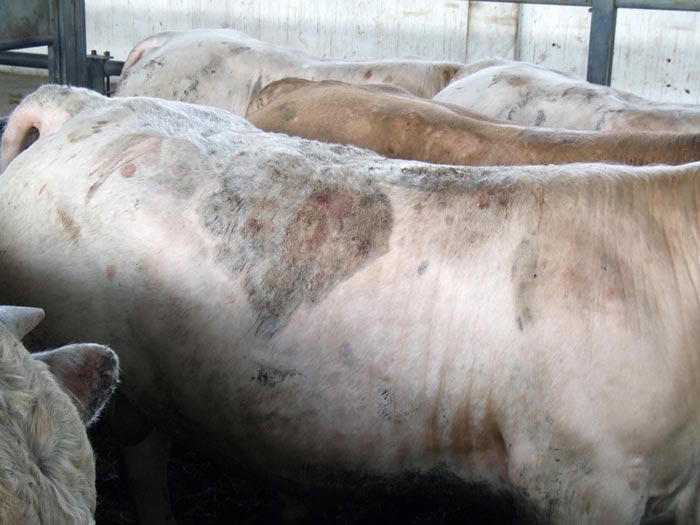
A common observation across all breeds is an inconsistent response to a single treatment with a macrocyclic lactone (ML; Lekimme et al, 2010), which necessitates repeat treatments with an ML or off-label permethrin (Jones et al, 2008). No explanation of this poor response to treatment has been determined to date, but different pharmacokinetics of the MLs among different breeds does not appear to be a factor (Vercruysse et al, 2008).
In addition, the response to ivermectin treatment of cattle with psoroptic mange has been shown to differ according to the product source (Genchi et al, 2008).
Lice
Lice are parasitic insects that can be found on a variety of warm-blooded hosts, including many species of birds and mammals.
In mammals, they live in the coat, are uniquely adapted to the hair of their host and exhibit a high level of host-specificity. In cattle, lice can be divided into two functional groups – biting/chewing and sucking lice. The latter have mouthparts that can penetrate intact skin and feed on blood; biting lice feed on bacteria and detritus on the skin surface.
All four species found in cattle are visible to the naked eye and measure from 2mm to 5mm. Predilection sites for the different species are related to their biology; therefore, biting lice are commonly found in the dense coat on the neck and withers, whereas sucking lice are more generally found on parts of the body with shorter hair, such as the head (Figure 7), where they can easily access and puncture the skin.
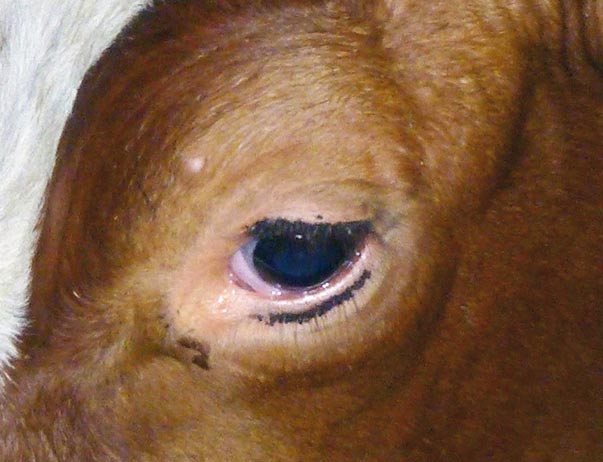
The impact of lice seems to be quite variable, ranging from death through anaemia in calves infested with the sucking lice of the species Linognathus vituli (Otter et al, 2003) to little or no effect on performance (Chalmers and Charleston, 1980; Cummins and Graham, 1982; Gibney et al, 1985).
What is clear from observations on lice-infested cattle is pruritus associated with lice infestations disrupts normal behaviour (Weeks et al, 1995), which, therefore, has a welfare impact, and can result in hair loss (Figure 8) and self-trauma. Another effect of lice, which is generally not appreciated at farm level, is damage to the hide, which has serious ramifications on the leather industry (Coles et al, 2003; Hadley et al, 2005).
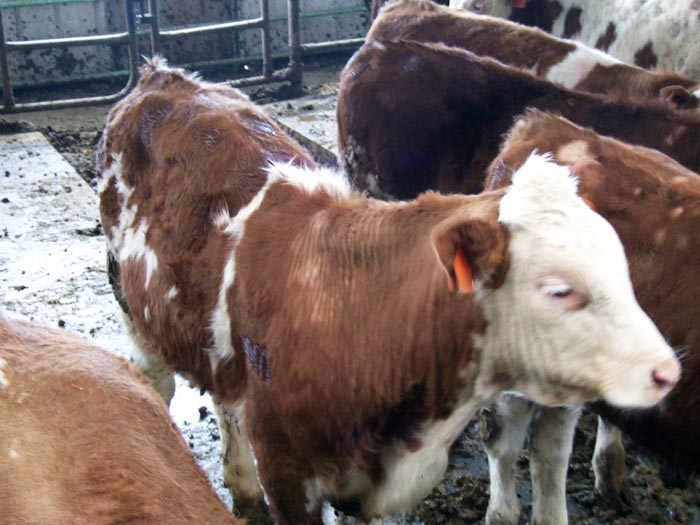
Treatment and control of mange and lice
Ectoparasiticides
The treatment of mange and lice is based on the judicious application of acaricides and insecticides, collectively known as ectoparasiticides. Table 1 lists the spectrum of activity of products registered in the UK and, as can be seen, the active ingredients fall into just two classes – the pyrethroids and the MLs.
| Table 1. Summary information of UK-licensed ectoparasiticides that can be used in the treatment and control of lice and mange in cattle | |||||||
|---|---|---|---|---|---|---|---|
| Chemical | Formulation | Mange mite genera | Lice biotypes | Milk withhold | |||
| Chorioptes | Sarcoptes | Psoroptes | Biting | Sucking | |||
| Alphacypermethrin | Pour-on | X | X | Zero | |||
| Deltamethrin | Pour-on, spot-on | X | X | Zero | |||
| Permethrin | Pour-on | X | X | X | X | Zero | |
| Doramectin | Pour-on | X | X | X | X | X | 60 days* |
| Injection | (X) | X | X | (X) | X | 60 days* | |
| Eprinomectin | Pour-on | X | X | X | X | Zero | |
| Injection | X | X | Zero | ||||
| Ivermectin | Pour-on | X | X | X | X | 60 days* | |
| Ivermectin** | Injection | (X) | X | X | (X) | X | 60 days* |
| Moxidectin** | Pour-on | X | X | X | X | X | 6 days |
| Injection/LAI | (X) | X | X | (X) | X | 60 to 80 days* | |
| X = used in treatment of; (X) = aid in the control of. *Not to be used in lactating dairy cows – only in dry cows or heifers at least 60 to 80 days prior to calving. **The claims are generally the same whether in single active formulations or in combination (for example, with a flukicide). |
|||||||
All the pyrethroids are administered topically, while the MLs can be given topically or by injection, although the spectrum of activity varies accordingly, with injectables having incomplete efficacy against surface feeder parasites – biting lice and chorioptic mange mites.
Several products have claims for persistent activity against various ectoparasite species (Cleale et al, 2004; Villeneuve and Daigneault, 1997); however, clinical/parasitological studies indicate a correctly applied single treatment with a licensed product is sufficient to effect a cure (Meleney et al, 1982; Titchener et al, 1994; Wright and Guillot, 1984).
This indicates parasiticidal concentrations of drug must be present for sufficient time after treatment to affect newly emerged juveniles, as none of the compounds have an effect against ectoparasite eggs.
Responsible use
Dependence on only two classes of actives inevitably results in selection pressure for resistance, and tolerance to deltamethrin has been reported in the biting louse, Bovicola bovis (Sands et al, 2015).
Nonetheless, before assuming apparent inefficacy is caused by resistance, it is crucial basic rules are followed.
These include:
- Select a product appropriate to the parasite(s) to be treated – if an injectable ML is used as a housing treatment, farmers should be advised it may be necessary to treat cattle topically for biting lice or chorioptic mange later in the winter because of incomplete efficacy against these species.
- Administer the product according to the label instructions, noting any precautions.
- Dose accurately – check the application equipment for the precision of volume delivered and weigh animals.
- Treat all animals in a group at the same time.
- Avoid contact between treated and untreated animals – adjacent pens and bought-in stock.
- Be alert to the fact that some parasites, particularly C bovis, can survive for a few weeks or more off the host in the environment.
While several acaricides/insecticides have been developed for use in pets, other than essentials oils (Ellse and Wall, 2014), little research into the use of these molecules singly or in combination appears to have been done in farm animals.
Control
Lice and mange are common and contagious, but not ubiquitous in cattle; hence, at the farm level, adequate control can be achieved through strategic treatment of at-risk groups of cattle. The most common time for treatment to occur is when cattle are housed for the winter.
At this time of year, lice and mite populations are typically low and located in cryptic sites on the body, such as the tail, perineum and ears. As winter progresses and conditions become more favourable, parasite populations increase, such that, by late winter/early spring, clinically relevant numbers can be present on untreated cattle.
Housing treatment with a pyrethroid or a topical ML can remove the cryptic parasite populations and, therefore, remove the risk of disease subsequently.
Because both lice and mange mites are obligate – species-specific parasites with limited survival off the host – they are legitimate candidates for elimination, at least at the farm level. Reports are available of successful implementation of elimination of parasites through synchronous ectoparasiticide treatments for these parasites (Nafstad and Grønstøl , 2001; Schönberg et al, 2000; Watson and Forbes, 2000).
Elimination may be an option in some herds, but factors such as cost-effectiveness, the longevity of the parasites off the host (Heath, 1973; Liebisch et al, 1985) and biosecurity should also be considered before embarking on such a programme.
Conclusion
Lice and mange are relatively common infestations in housed cattle over winter and, though few reliable data exist on prevalence, field observations indicate biting lice and chorioptic mange are the most common of the seven lice and mite species that infect cattle.
Both species live and feed superficially, and optimal treatments should be based around topical formulations of ectoparasiticides. Few options exist for non-chemical control, but research into alternative methods would help take some of the pressure off the two commonly used classes of insecticide/acaricide.
